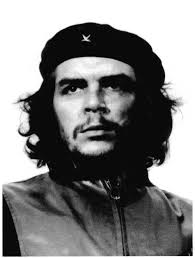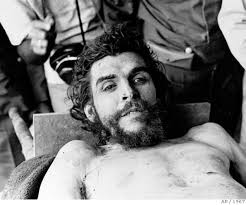Che Guevara: revolution hero
>> Thursday, February 11, 2010

Che Guevara, leader of the Communist Revolution in Cuba, is still honored by the Castro government.
Ernesto Guevara was born on June 14, 1928 in Rosario, Argentina, into an upper-middle class ranching family. Around the age of two, he developed asthma, a condition from which he suffered his entire life. His parents moved to the province of Cordoba, hoping that the drier air would improve their son’s condition. It didn’t, and Ernesto was a frail, sickly child. As he could not engage in the rough play of the other boys, he became quite the little intellectual, reading Marx and Engels before the onset of puberty. His family, the Guevara de la Sernas, were opposed to the dictatorship of Juan Peron, and his mother in particular was quite active in anti-Peronist demonstrations.
As a student at Buenos Aires University in the late 1940’s, Guevara surprisingly took no interest in the revolutionary students’ movement. He was a quiet young man who studied medicine, specializing in the study of leprosy. He went to Peru to observe the disease in a leper colony. He also visited Colombia, Venezuela, and Miami before returning home to Argentina. He had become a Marxist during his travels
, and now scoffed at the notion of becoming a middle-class doctor. In September of1954, he went to Mexico City, taking a residency in the General Hospital. Soon after he met Fidel Castro, who was in political exile from Cuba.
Guevara became a disciple of Castro’s, and pledged to help him overthrow the corrupt dictatorship of Fulgencio Batista in Cuba. On a farm in Mexico, Guevara and other revolutionaries were received training in guerrilla warfare by a Spanish Republican Army captain. It was here that he was nicknamed “Che,” which means “buddy” or “pal” in Italian
. Both Che and Castro were arrested by Mexican authorities during this time, but both were released. Castro knew that he could no longer bide his time in Mexico, and so the Cuban Revolution began.
Che served as both doctor and Commandante in the Revolution, and was a harsh taskmaster to the soldiers under him. He insisted that his soldiers not only give themselves physically to the war, but that they have the correct Marxist state of mind. He was cruel and ruthless when it came to prisoners or defectors, presiding over mass executions without blinking an eye. His single-mindedness was greatly prized by Castro, who made him his right hand man and the Minister for Industry when Batista’s government was overthrown. Shortly after the Revolution, Che married Aledia March, and they went on an extended honeymoon.
When Che returned to Cuba, he concentrated on moving Castro ever more to the left, and began to study the policies Mao Tse-tung was using China. While Castro wanted to be cautious in his economic reforms, Che was convinced that a quick and complete overhaul was necessary. Che’s ideas proved disastrous in practice, and in 1965, Fidel asked him to resign and direct his efforts elsewhere. Che took 120 Cubans with him to the African Congo in an attempt to foment Communist revolution that failed.
Che turned his attention to South America. He believed that Bolivia would be his best bet to start a revolt, because of its discontented peasant population and the United States’ relative lack of interest in it. He grossly misjudged the political climate, however, and found it difficult to recruit soldiers. He was captured by Bolivian Army troops on October 8, 1967. The army was in a quandary as to what to do with him; they feared a trial would only stir up support for the revolutionary. The next day they executed Che Guavera by shooting him in his cell. Che reportedly said, “Go ahead, you are only killing a man.”
Fidel Castro at first refused to believe the reports of his death, then turned it into a publicity bonanza for the Cuban government, which continues to this day.

0 comments:
Post a Comment